What is the difference between borscht and cabbage soup?
To understand the difference between borscht and cabbage soup, just look at traditional recipes. Borscht, green borscht and cabbage soup are types of vegetable soups. The difference between the dishes lies in the use of special ingredients. In classic borscht it is beets, in green borscht it is sorrel and eggs, in cabbage soup it is often sauerkraut. Cabbage soup is also characterized by great variability in ingredients.
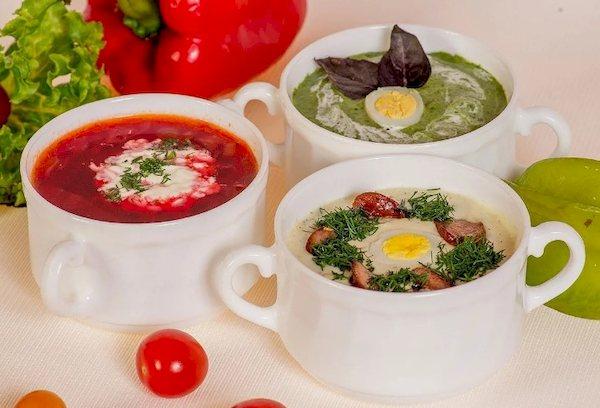
How to distinguish borscht from cabbage soup?
It is not always possible to distinguish borscht from cabbage soup. Many housewives use family recipes that bear little resemblance to traditional ones. Easily accessible and maximally satisfying foods are added to the dishes: all kinds of green herbs, beans, eggs. This is why cabbage soup and borscht lose their uniqueness and it is no longer possible to infect them with precision.
But what is the difference between dishes prepared according to the standard? Let's look at the table:
| Cabbage soup | Red borscht | Green | |
| Color | any | red | green |
| Taste | usually sour | sour or sweet and sour | refreshing, sour |
| Main component | sauerkraut or other highly acidic product;
variety of ingredients |
beets, fresh and sour cabbage | plenty of greens, egg |
| Peculiarity | cooking raw foods (cabbage is sometimes stewed) | preliminary heat treatment of products (passivation, frying) | the greens are not boiled, but added at the end |
| Season | all year round | autumn winter | spring and summer |
| Difficulty of preparation | Just | difficult | average |
Difference in photo:
What is cabbage soup?
In Old Russian the dish was called “shti”.Shchi was prepared with lean and meaty cabbage, from sauerkraut and fresh chopped cabbage, or with sorrel, or beets. A dish could include dozens of different components. Shti were cooked in cereal, fish, mushroom, vegetable, and meat broths. Tomatoes and apples could be added.
The name "cabbage soup", according to one version, comes from the Old Russian "s'to" ("sti"), which means "sustenance", "hearty food".
Shchi (shti) has long been the main hot dish of Russian cuisine. As the saying goes. “cabbage soup and porridge are our food.” There was no single recipe for cabbage soup. In each locality, for different occasions, the dish was prepared in a special way. There are at least 24 recipes: empty, Ural, Don, Tsar’s, Griboyedov’s, boyar’s, Morochanskie cabbage soup, etc.
Despite the numerous variations of the dish, there were general cooking rules:
- cooking (other stews could be prepared by simply diluting with water);
- thick consistency;
- high nutritional value (they satisfy hunger well);
- acid.
Cabbage soup (shti) was often whitened with sour cream and flour was added for thickness. One of the old recipes:
In its modern version, the characteristic differences of cabbage soup are:
- Add raw foods (not fried).
- Using sauerkraut.
- Use of herbs.
- Possibility of adding soaked apples, salted mushrooms and other non-standard ingredients for soups.
What is borscht?
In Dahl's explanatory dictionary, borscht refers to pickled beets and soup made from them. In the old days, the dish was prepared in the likeness of cabbage soup. Only instead of sauerkraut, sour beets were used. Therefore, it was sometimes called shti (cabbage soup) borscht, that is, beet soup.
By the way, invigorating beet kvass was prepared from pickled beets. Borscht with its addition was called borscht soup with juice.Red borscht was the main first course among the Eastern Slavs (and Ukrainians, in particular).
Standard composition:
- vegetables: beets, cabbage, potatoes, onions, tomatoes, carrots;
- spices: black and allspice, bay leaf;
- green herbs: parsley, dill.
Borscht is prepared with fresh and sour cabbage. If sauerkraut is not added, vinegar is used for acidity, or less often lemon juice. Very often the recipe includes garlic, sometimes beans, lard, bell peppers, turnips, zucchini, celery, thyme, lovage, basil, tarragon, marjoram.
Today beets are mainly used not pickled, but baked (boiled, stewed). This gives the dish a sweetness. If the sugar content of beets is not enough, it is often sweetened with sugar. Classic borscht is thick. It can be lean or lean - with meat, meat and bone broth or bone broth.
Green borscht: what is known about it?
The Eastern Slavs cooked red borscht in the cold season after the beet harvest, and green borscht in the spring, with the appearance of young greens. It is sometimes also called the Ukrainian analogue of Russian sorrel soup.
Green borscht made from the following products is considered traditional:
- meat broth with meat;
- vegetables: potatoes, carrots, onions;
- greens: sorrel, nettle, dill, parsley, onion;
- eggs - chicken or any other bird.
In the old days, the dish was also prepared with the addition of dandelion leaves. As for the egg, in homemade green borscht it is broken directly into the pan. It is allowed to grate eggs on a fine grater. A dish with neat halves or quarters of eggs looks more presentable.
Question answer
What is the difference between green cabbage soup and green borscht?
Lack of eggs. Cabbage soup, as a rule, contains more different ingredients added for richness, including cabbage.Green borscht invariably contains sorrel and young nettle. There is also a difference in preparation: in the first dish, herbs are added twice, and in the second - once, at the very end.
What is the difference between cabbage soup with beets and borscht?
Raw beets (fermented, pickled, sometimes canned) are placed in the cabbage soup.
In conclusion, cabbage soup is considered the simplest dish. Vegetables for it do not require sautéing or frying. All components are placed immediately into the pan. Good red borscht, thick and rich, takes several hours to prepare. You need to make a separate dressing to balance the sweetness and acidity. The difference between the dishes is significant in composition, processes, and taste.
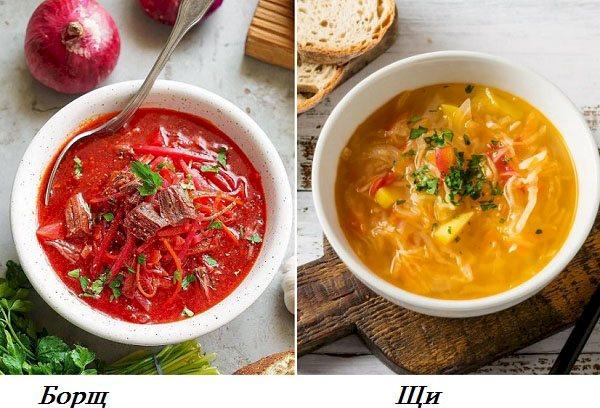
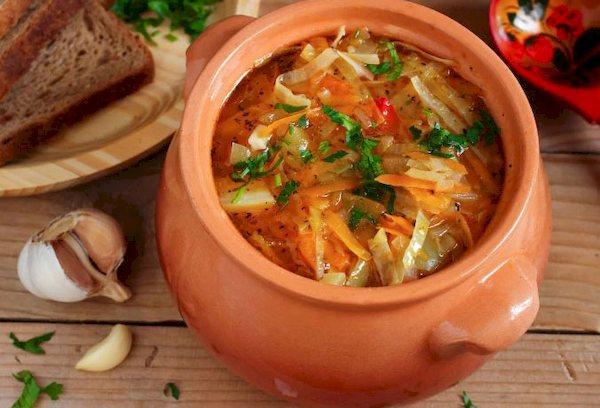
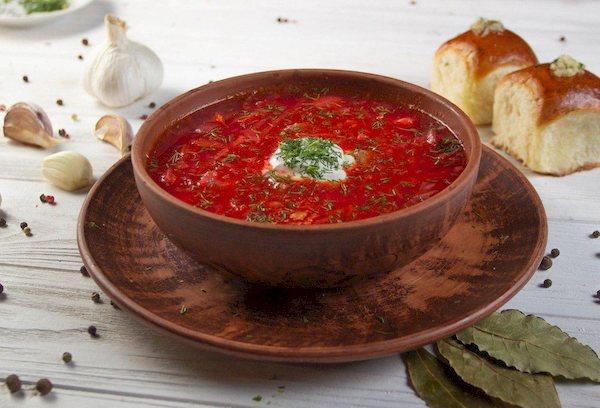
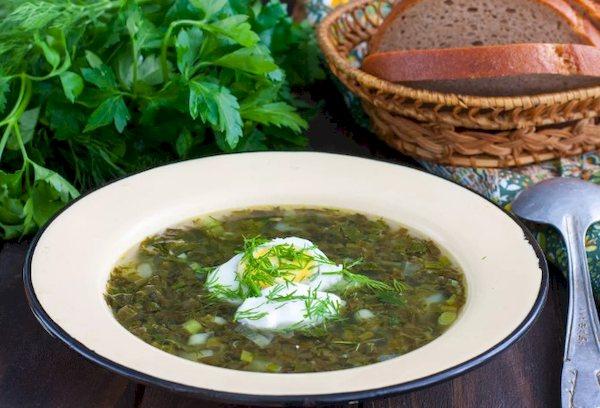
What is the difference between Borscht and Shchi?
Briefly: The technology for preparing these dishes.
Borscht is cooked on a stove (wood, coal, gas, electric), which allows the cook to prepare this dish operationally, that is, add the ingredients of the borscht at different times of its preparation.
The cabbage soup was prepared in a Russian oven, the purpose of which is to heat the home, but cooking pickles in it is impossible. You can say that a Russian stove has an improvised stove; this unfortunate innovation appeared recently and not everyone has it.
They took cast iron, put the ingredients from A to Z into it and placed it (cast iron) in a heated oven with a grip for 2 - 2.5 hours with the damper closed.
What unites these two dishes is the presence of cabbage in both Borscht and Shchi. The remaining ingredients depend on the cook’s “pocket”, i.e. there is money for meat, meat has been stored, etc.
They put cabbage in the borscht so that it was not “mushy” - overcooked, but had a crunch, and was cooked in the borscht for no more than 18 - 20 minutes, i.e. last.
I repeat: The remaining ingredients depend on the cook’s “pocket”. Due to this, there were so-called “empty” Shchi and Borscht. Beets don’t roll here at all, especially since on the second day borscht with beets changes color, and in the south many housewives cook borscht overnight so that they can eat it the next day. Indeed, borscht tastes much better the next day.
And also, since borscht is a sour dish, the potatoes in it are pounded with a masher, this was done just in the last 18 minutes. cooking the dish. Why do they do this? On the second day the potatoes in the borscht will turn out to be “glass”, but the crushed ones will not.
I have never eaten Shchi in my life, but I have eaten spoiled borscht called Shchi, so I didn’t like this dish.
How is this known? In the early 80s, a detailed article was published in the journal “Science and Life” on this topic with historical research; only verified articles were published in this magazine.
When I started living a family life, I had to teach my young wife to cook delicious food, because...In central Russia, mostly women do not know how to cook food and waste food in vain. I was born in exile, and there, as I realized later, living in the middle zone, more comprehensively educated people were actually gathered. In addition, it was believed that a man must be able to cook tasty and nutritious food. I am 73 years old.